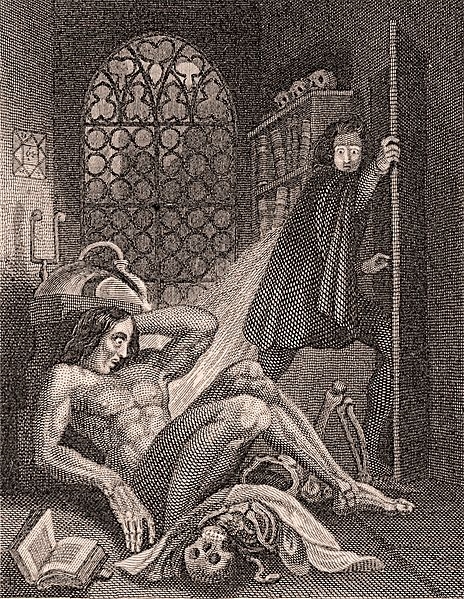Have you ever noticed that Victor Frankenstein seems ... well ... a bit whiny? You're not alone. Whether you're in a book club, high school class, graduate school seminar, or special collections library, Victor Frankenstein's constant complaining makes it seem like he spends "90% of the novel moping instead of doing literally anything else." [1]
My quick keyboard-shortcut search of Mary Shelley's 1818 text* yields the estimate that, within the novel, variations of the word "wretch" are used over 60 times, and variations of "miserable" or "misery" occur over 100 times. Often, these words are used to describe Victor himself, as he bemoans, and bemoans, and bemoans the misfortune of having accomplished exactly what he was trying to do.
Some viral social media posts have joked that this is because, contrary to popular film depictions, "Doctor" Frankenstein "WAS AN UNDERGRAD" [capitalization retained from original] who "...had no degree at all, he was at college for like, a year." One Tumblr user comedically calls Victor a "19-year-old sin machine," and another suggests that to recontextualize how we might view Victor today, we should: "Imagine hearing about the dudebro living next to u [sic] in the dorms: 'yah Dave dropped out cuz he built a [...] person.'" [2]
"Yah, Dave dropped out cuz he built a person." In the frontispiece of the 1831 edition of Mary Shelley's novel, "19-year-old sin machine" Victor Frankenstein flees the scene of his monstrous act of creation.
Shelley, Mary. Frankenstein (London: Henry Colburn and Richard Bentley), 1831. Eaton Collection. From the holdings of Special Collections and University Archives, UCR Library, University of California, Riverside.
Hilarious and valid as these arguments may be, which attribute Victor's moping to his age, immaturity, and hubris, Mary Shelley herself seems to have intended for Victor Frankenstein to be as overtly whiny as he is. In her introduction to the 1831 edition of her novel, she explains her inspiration behind Victor and his Creature:
My imagination, unbidden, possessed and guided me, gifting the successive images that arose in my mind with a vividness far beyond the usual bounds of reverie. I saw -- with shut eyes, but acute mental vision, -- I saw the pale student of unhallowed arts kneeling beside the thing he had put together. I saw the hideous phantasm of a man stretched out, and then, on the working of some powerful engine, show signs of life, and stir with an uneasy, half vital motion. Frightful must it be; for supremely frightful would be the effect of any human endeavor to mock the stupendous mechanism of the Creator of the world. His success would terrify the artist; he would rush away from his odious handywork, horror-stricken. He would hope that, left to itself, the slight spark of life which he had communicated would fade; that this thing, which had received such imperfect animation, would subside into dead matter; and he might sleep in the belief that the silence of the grave would quench for ever the transient existence of the hideous corpse which he had looked upon as the cradle of life. He sleeps; but he is awakened; he opens his eyes; behold the horrid thing stands at the bedside, opening his curtains, and looking on him with yellow, watery, but speculative eyes. [3]
True to her inspiration, Shelley's fiction brings this imaginary scene to life on the printed page, using intensely emotional language to craft the story's miserable tone and characterize the voice of our wretched Victor. The Creature haunts Victor's every sleeping and waking thought, as he always stands at his Creator's literal and metaphorical bedside, wide eyes "following" the guilty Victor, no matter how far he flees.
As a jokey, all-in-good-fun addition to the FrankenBlog, I have created the Twitter account @whinypantsfrank, which places images of the "whiniest" passages from Mary Shelley's original novel alongside humorous Tweets that use millennial punctuation and capitalization conventions to emphasize Victor's misery. Click here to follow Whiny Frankenstein!
[1] This quotation comes from a viral Tumblr blog post, which can be viewed here.
[2] See footnote 1. Some spelling and punctuation modified from original for clarity.
[3] Appendix G: Introduction. In Frankenstein: the Original 1818 Text. By Mary Shelley, edited by D.L. Macdonald and Kathleen Scherf (Ontario: Broadview Press, 1999), page 357. Bold print added for emphasis.

